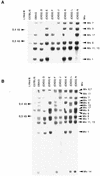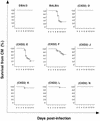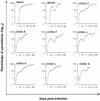Deletion of T cells bearing the V beta8.1 T-cell receptor following mouse mammary tumor virus 7 integration confers resistance to murine cerebral malaria
- PMID: 12065512
- PMCID: PMC128078
- DOI: 10.1128/IAI.70.7.3701-3706.2002
Deletion of T cells bearing the V beta8.1 T-cell receptor following mouse mammary tumor virus 7 integration confers resistance to murine cerebral malaria
Abstract
Plasmodium berghei ANKA induces a fatal neurological syndrome known as cerebral malaria (CM) in susceptible mice. Host genetic elements are among the key factors determining susceptibility or resistance to CM. Analysis of mice of the same H-2 haplotype revealed that mouse mammary tumor virus 7 (MTV-7) integration into chromosome 1 is one of the key factors associated with resistance to neurological disease during P. berghei ANKA infection. We investigated this phenomenon by infecting a series of recombinant inbred mice (CXD2), derived from BALB/c (susceptible to CM) and DBA/2 (resistant to CM) mice, with P. berghei ANKA. We observed differences in susceptibility to CM induced by this Plasmodium strain. Mice with the MTV-7 sequence in their genome were resistant to CM, whereas those without integration of this gene were susceptible. Thus, an integrated proviral open reading frame or similar genomic sequences may confer protection against neuropathogenesis during malaria, at least in mice.
Figures






Similar articles
-
Association of a determinant on mouse chromosome 18 with experimental severe Plasmodium berghei malaria.Infect Immun. 2002 Feb;70(2):512-6. doi: 10.1128/IAI.70.2.512-516.2002. Infect Immun. 2002. PMID: 11796577 Free PMC article.
-
MDR1A (ABCB1)-deficient CF-1 mutant mice are susceptible to cerebral malaria induced by Plasmodium berghei ANKA.J Parasitol. 2008 Oct;94(5):1139-42. doi: 10.1645/GE-1493.1. J Parasitol. 2008. PMID: 18973419
-
T cell response in malaria pathogenesis: selective increase in T cells carrying the TCR V(beta)8 during experimental cerebral malaria.Int Immunol. 1999 Sep;11(9):1553-62. doi: 10.1093/intimm/11.9.1553. Int Immunol. 1999. PMID: 10464176
-
Genetic analysis of cerebral malaria in the mouse model infected with Plasmodium berghei.Mamm Genome. 2018 Aug;29(7-8):488-506. doi: 10.1007/s00335-018-9752-9. Epub 2018 Jun 19. Mamm Genome. 2018. PMID: 29922917 Review.
-
Unravelling the roles of innate lymphoid cells in cerebral malaria pathogenesis.Parasite Immunol. 2018 Feb;40(2). doi: 10.1111/pim.12502. Parasite Immunol. 2018. PMID: 29117626 Review.
Cited by
-
Reasons why DBA/2 mice are resistant to malarial infection: expansion of CD3int B220+ gammadelta T cells with double-negative CD4- CD8- phenotype in the liver.Immunology. 2006 Jan;117(1):127-35. doi: 10.1111/j.1365-2567.2005.02273.x. Immunology. 2006. PMID: 16423048 Free PMC article.
-
Comparative study of brain CD8+ T cells induced by sporozoites and those induced by blood-stage Plasmodium berghei ANKA involved in the development of cerebral malaria.Infect Immun. 2004 May;72(5):2817-26. doi: 10.1128/IAI.72.5.2817-2826.2004. Infect Immun. 2004. PMID: 15102792 Free PMC article.
-
An opinion on the debatable function of brain resident immune protein, T-cell receptor beta subunit in the central nervous system.IBRO Neurosci Rep. 2022 Sep 6;13:235-242. doi: 10.1016/j.ibneur.2022.09.003. eCollection 2022 Dec. IBRO Neurosci Rep. 2022. PMID: 36590097 Free PMC article.
-
Endogenous mouse mammary tumor viruses (mtv): new roles for an old virus in cancer, infection, and immunity.Front Oncol. 2013 Nov 26;3:287. doi: 10.3389/fonc.2013.00287. Front Oncol. 2013. PMID: 24324930 Free PMC article. Review.
-
Deletion of Vβ3+CD4+ T cells by endogenous mouse mammary tumor virus 3 prevents type 1 diabetes induction by autoreactive CD8+ T cells.Proc Natl Acad Sci U S A. 2023 Dec 5;120(49):e2312039120. doi: 10.1073/pnas.2312039120. Epub 2023 Nov 28. Proc Natl Acad Sci U S A. 2023. PMID: 38015847 Free PMC article.
References
-
- Bagot, S., M. I. Boubou, S. Campino, C. Behrschmidt, O. Gorgette, J.-L. Guénet, C. Penha-Gonçalves, D. Mazier, S. Pied, and P.-A. Cazenave. 2002. Susceptibility to experimental cerebral malaria induced by Plasmodium berghei ANKA in inbred mouse strains recently derived from wild stock. Infect. Immun. 70:2049-2056. - PMC - PubMed
-
- Boubou, M. I., A. Collette, D. Voegtle, D. Mazier, P. A. Cazenave, and S. Pied. 1999. T-cell response in pathogenesis: selective increase in T cells carrying the TCR Vβ8 during experimental cerebral malaria. Int. Immunol. 11:1553-1562. - PubMed
-
- Cazala, P., and J. L. Guenet. 1980. Recombinant inbred strains: a tool for the genetic analysis of differences observed in the self-stimulation behavior of the mouse. Physiol. Behav. 24:1057-1060. - PubMed
Publication types
MeSH terms
Substances
LinkOut - more resources
Full Text Sources
Molecular Biology Databases

